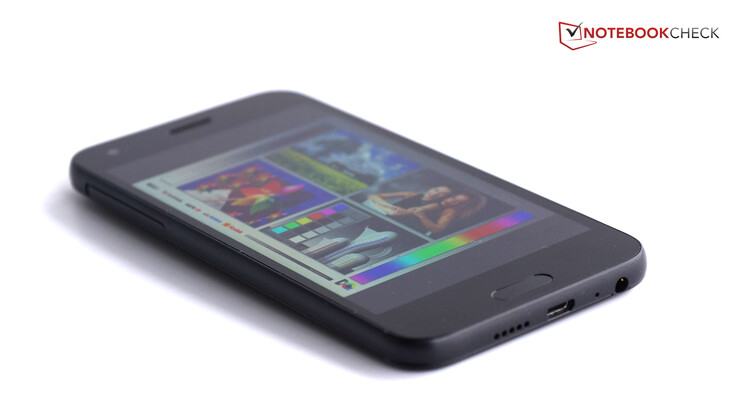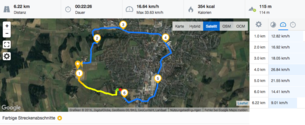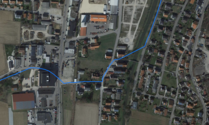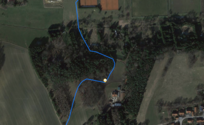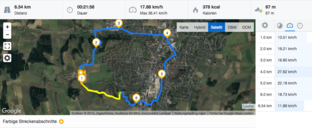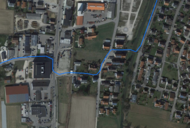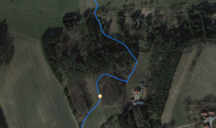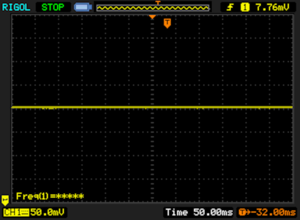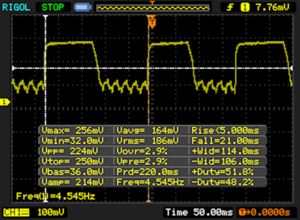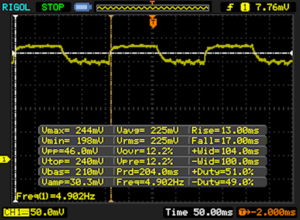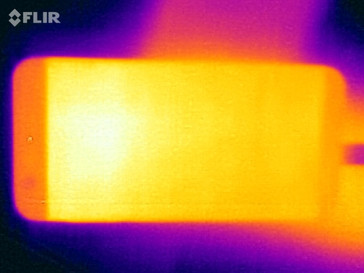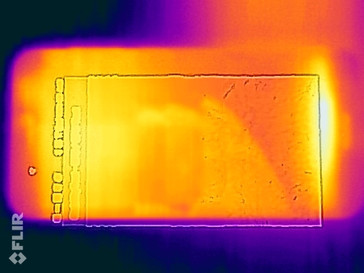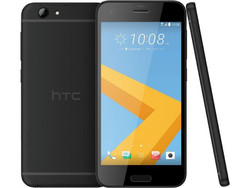HTC One A9s 智能手机简短评测
Case
» Notebookcheck多媒体笔记本电脑Top 10排名
» Notebookcheck游戏笔记本电脑Top 10排名
» Notebookcheck低价办公/商务笔记本电脑Top 10排名
» Notebookcheck高端办公/商务笔记本电脑Top 10排名
» Notebookcheck工作站笔记本电脑Top 10排名
» Notebookcheck亚笔记本电脑Top 10排名
» Notebookcheck超级本产品Top 10排名
» Notebookcheck变形本产品Top 10排名
» Notebookcheck平板电脑Top 10排名
» Notebookcheck智能手机Top 10排名
» Notebookcheck评测过最出色的笔记本电脑屏幕
» Notebookcheck售价500欧元以下笔记本电脑Top 10排名
» Notebookcheck售价300欧元以下笔记本电脑Top 10排名
Size Comparison
Connectivity
| Networking | |
| iperf3 transmit AX12 | |
| Apple iPhone 7 (Klaus I211) | |
| Samsung Galaxy S7 | |
| HTC One A9s | |
| HTC Desire 10 Lifestyle | |
| iperf3 receive AX12 | |
| Apple iPhone 7 (Klaus I211) | |
| Samsung Galaxy S7 | |
| HTC One A9s | |
| HTC Desire 10 Lifestyle | |
Display
| |||||||||||||||||||||||||
Brightness Distribution: 85 %
Center on Battery: 348 cd/m²
Contrast: 1513:1 (Black: 0.23 cd/m²)
ΔE ColorChecker Calman: 3.5 | ∀{0.5-29.43 Ø4.78}
ΔE Greyscale Calman: 4 | ∀{0.09-98 Ø5}
95.1% sRGB (Calman 2D)
Gamma: 2.3
CCT: 6527 K
| HTC One A9s IPS, 1280x720, 5" | OnePlus 2 IPS, 1920x1080, 5.5" | Lenovo ZUK Z2 IPS, 1920x1080, 5" | Gigaset ME IPS, 1920x1080, 5" | Samsung Galaxy A5 2016 Super AMOLED, 1920x1080, 5.2" | HTC One A9 AMOLED, 1920x1080, 5" | |
|---|---|---|---|---|---|---|
| Screen | 5% | -18% | -10% | 31% | 24% | |
| Brightness middle (cd/m²) | 348 | 451 30% | 512 47% | 445 28% | 378 9% | 346 -1% |
| Brightness (cd/m²) | 320 | 446 39% | 502 57% | 456 43% | 380 19% | 349 9% |
| Brightness Distribution (%) | 85 | 90 6% | 84 -1% | 93 9% | 91 7% | 93 9% |
| Black Level * (cd/m²) | 0.23 | 0.3 -30% | 0.58 -152% | 0.38 -65% | ||
| Contrast (:1) | 1513 | 1503 -1% | 883 -42% | 1171 -23% | ||
| Colorchecker dE 2000 * | 3.5 | 3.84 -10% | 3.8 -9% | 4.29 -23% | 1.95 44% | 1.55 56% |
| Colorchecker dE 2000 max. * | 6.4 | 11.2 -75% | 7.89 -23% | 3.09 52% | ||
| Greyscale dE 2000 * | 4 | 3.97 1% | 2.7 32% | 4.97 -24% | 1.86 53% | 2.05 49% |
| Gamma | 2.3 96% | 2.46 89% | 2.09 105% | 2.57 86% | 2.13 103% | 2.15 102% |
| CCT | 6527 100% | 7283 89% | 6076 107% | 7625 85% | 6376 102% | 6267 104% |
| Color Space (Percent of AdobeRGB 1998) (%) | 58.07 | |||||
| Color Space (Percent of sRGB) (%) | 90.14 |
* ... smaller is better
Screen Flickering / PWM (Pulse-Width Modulation)
| Screen flickering / PWM not detected | |||
In comparison: 53 % of all tested devices do not use PWM to dim the display. If PWM was detected, an average of 8118 (minimum: 5 - maximum: 343500) Hz was measured. | |||
Display Response Times
| ↔ Response Time Black to White | ||
|---|---|---|
| 26 ms ... rise ↗ and fall ↘ combined | ↗ 5 ms rise | |
| ↘ 21 ms fall | ||
| The screen shows relatively slow response rates in our tests and may be too slow for gamers. In comparison, all tested devices range from 0.1 (minimum) to 240 (maximum) ms. » 61 % of all devices are better. This means that the measured response time is worse than the average of all tested devices (20.2 ms). | ||
| ↔ Response Time 50% Grey to 80% Grey | ||
| 30 ms ... rise ↗ and fall ↘ combined | ↗ 13 ms rise | |
| ↘ 17 ms fall | ||
| The screen shows slow response rates in our tests and will be unsatisfactory for gamers. In comparison, all tested devices range from 0.165 (minimum) to 636 (maximum) ms. » 39 % of all devices are better. This means that the measured response time is similar to the average of all tested devices (31.6 ms). | ||
Performance
| AnTuTu v6 - Total Score (sort by value) | |
| HTC One A9s | |
| OnePlus 2 | |
| Lenovo ZUK Z2 | |
| Gigaset ME | |
| Samsung Galaxy A5 2016 | |
| Geekbench 4.0 | |
| 64 Bit Single-Core Score (sort by value) | |
| HTC One A9s | |
| 64 Bit Multi-Core Score (sort by value) | |
| HTC One A9s | |
| GFXBench (DX / GLBenchmark) 2.7 | |
| T-Rex Onscreen (sort by value) | |
| HTC One A9s | |
| OnePlus 2 | |
| Lenovo ZUK Z2 | |
| Gigaset ME | |
| Samsung Galaxy A5 2016 | |
| HTC One A9 | |
| 1920x1080 T-Rex Offscreen (sort by value) | |
| HTC One A9s | |
| OnePlus 2 | |
| Lenovo ZUK Z2 | |
| Gigaset ME | |
| Samsung Galaxy A5 2016 | |
| HTC One A9 | |
| GFXBench 3.0 | |
| on screen Manhattan Onscreen OGL (sort by value) | |
| HTC One A9s | |
| OnePlus 2 | |
| Lenovo ZUK Z2 | |
| Gigaset ME | |
| Samsung Galaxy A5 2016 | |
| HTC One A9 | |
| 1920x1080 1080p Manhattan Offscreen (sort by value) | |
| HTC One A9s | |
| OnePlus 2 | |
| Lenovo ZUK Z2 | |
| Gigaset ME | |
| Samsung Galaxy A5 2016 | |
| HTC One A9 | |
| GFXBench 3.1 | |
| on screen Manhattan ES 3.1 Onscreen (sort by value) | |
| HTC One A9s | |
| OnePlus 2 | |
| Lenovo ZUK Z2 | |
| Gigaset ME | |
| HTC One A9 | |
| 1920x1080 Manhattan ES 3.1 Offscreen (sort by value) | |
| HTC One A9s | |
| OnePlus 2 | |
| Lenovo ZUK Z2 | |
| Gigaset ME | |
| HTC One A9 | |
| PCMark for Android - Work performance score (sort by value) | |
| HTC One A9s | |
| OnePlus 2 | |
| Lenovo ZUK Z2 | |
| Gigaset ME | |
| Samsung Galaxy A5 2016 | |
| HTC One A9 | |
| Octane V2 - Total Score (sort by value) | |
| HTC One A9s | |
| OnePlus 2 | |
| Lenovo ZUK Z2 | |
| Gigaset ME | |
| Samsung Galaxy A5 2016 | |
| HTC One A9 | |
| Mozilla Kraken 1.1 - Total (sort by value) | |
| HTC One A9s | |
| OnePlus 2 | |
| Lenovo ZUK Z2 | |
| Gigaset ME | |
| Samsung Galaxy A5 2016 | |
| HTC One A9 | |
| WebXPRT 2015 - Overall (sort by value) | |
| HTC One A9s | |
| OnePlus 2 | |
| Samsung Galaxy A5 2016 | |
| HTC One A9 | |
| JetStream 1.1 - Total Score (sort by value) | |
| HTC One A9s | |
| OnePlus 2 | |
| Lenovo ZUK Z2 | |
| Gigaset ME | |
| Samsung Galaxy A5 2016 | |
| HTC One A9 | |
* ... smaller is better
| AndroBench 3-5 | |
| Sequential Read 256KB (sort by value) | |
| HTC One A9s | |
| OnePlus 2 | |
| Lenovo ZUK Z2 | |
| Gigaset ME | |
| Samsung Galaxy A5 2016 | |
| HTC One A9 | |
| Sequential Write 256KB (sort by value) | |
| HTC One A9s | |
| OnePlus 2 | |
| Lenovo ZUK Z2 | |
| Gigaset ME | |
| Samsung Galaxy A5 2016 | |
| HTC One A9 | |
| Random Read 4KB (sort by value) | |
| HTC One A9s | |
| OnePlus 2 | |
| Lenovo ZUK Z2 | |
| Gigaset ME | |
| Samsung Galaxy A5 2016 | |
| HTC One A9 | |
| Random Write 4KB (sort by value) | |
| HTC One A9s | |
| OnePlus 2 | |
| Lenovo ZUK Z2 | |
| Gigaset ME | |
| Samsung Galaxy A5 2016 | |
| HTC One A9 | |
| Sequential Read 256KB SDCard (sort by value) | |
| HTC One A9s | |
| Sequential Write 256KB SDCard (sort by value) | |
| HTC One A9s | |
| Asphalt 8: Airborne | |||
| Settings | Value | ||
| high | 29 fps | ||
| very low | 30 fps | ||
| Dead Trigger 2 | |||
| Settings | Value | ||
| high | 58 fps | ||
Emissions
(+) The maximum temperature on the upper side is 33.5 °C / 92 F, compared to the average of 35.2 °C / 95 F, ranging from 21.9 to 247 °C for the class Smartphone.
(+) The bottom heats up to a maximum of 32.3 °C / 90 F, compared to the average of 34 °C / 93 F
(+) In idle usage, the average temperature for the upper side is 30.1 °C / 86 F, compared to the device average of 32.9 °C / 91 F.
HTC One A9s audio analysis
(+) | speakers can play relatively loud (82.6 dB)
Bass 100 - 315 Hz
(-) | nearly no bass - on average 18.2% lower than median
(±) | linearity of bass is average (13.5% delta to prev. frequency)
Mids 400 - 2000 Hz
(±) | higher mids - on average 5.4% higher than median
(+) | mids are linear (5.4% delta to prev. frequency)
Highs 2 - 16 kHz
(±) | higher highs - on average 11.7% higher than median
(±) | linearity of highs is average (8.3% delta to prev. frequency)
Overall 100 - 16.000 Hz
(±) | linearity of overall sound is average (28.6% difference to median)
Compared to same class
» 74% of all tested devices in this class were better, 4% similar, 22% worse
» The best had a delta of 11%, average was 35%, worst was 134%
Compared to all devices tested
» 86% of all tested devices were better, 3% similar, 12% worse
» The best had a delta of 4%, average was 24%, worst was 134%
Apple iPhone 7 audio analysis
(+) | speakers can play relatively loud (83.1 dB)
Bass 100 - 315 Hz
(-) | nearly no bass - on average 21.8% lower than median
(±) | linearity of bass is average (9.5% delta to prev. frequency)
Mids 400 - 2000 Hz
(+) | balanced mids - only 4.3% away from median
(+) | mids are linear (6% delta to prev. frequency)
Highs 2 - 16 kHz
(±) | higher highs - on average 5.9% higher than median
(±) | linearity of highs is average (8.2% delta to prev. frequency)
Overall 100 - 16.000 Hz
(±) | linearity of overall sound is average (20.9% difference to median)
Compared to same class
» 38% of all tested devices in this class were better, 8% similar, 54% worse
» The best had a delta of 11%, average was 35%, worst was 134%
Compared to all devices tested
» 56% of all tested devices were better, 8% similar, 36% worse
» The best had a delta of 4%, average was 24%, worst was 134%
Frequency Comparison (Checkboxes select/deselectable!)
Energy Management
| Off / Standby | |
| Idle | |
| Load |
|
Key:
min: | |
| HTC One A9s 2300 mAh | OnePlus 2 mAh | Lenovo ZUK Z2 3500 mAh | Gigaset ME 3000 mAh | Samsung Galaxy A5 2016 2900 mAh | HTC One A9 mAh | |
|---|---|---|---|---|---|---|
| Power Consumption | 13% | -4% | -20% | 25% | 25% | |
| Idle Minimum * (Watt) | 1.29 | 0.6 53% | 1.31 -2% | 0.75 42% | 0.96 26% | 0.9 30% |
| Idle Average * (Watt) | 2.28 | 1.7 25% | 2.03 11% | 1.7 25% | 1.64 28% | 1.2 47% |
| Idle Maximum * (Watt) | 2.52 | 1.8 29% | 2.08 17% | 1.84 27% | 1.71 32% | 1.4 44% |
| Load Average * (Watt) | 4.06 | 5.7 -40% | 5.45 -34% | 7.18 -77% | 2.98 27% | 3.8 6% |
| Load Maximum * (Watt) | 5.91 | 6 -2% | 6.75 -14% | 12.75 -116% | 5.08 14% | 5.9 -0% |
* ... smaller is better
| HTC One A9s 2300 mAh | OnePlus 2 mAh | Lenovo ZUK Z2 3500 mAh | Gigaset ME 3000 mAh | Samsung Galaxy A5 2016 2900 mAh | HTC One A9 mAh | |
|---|---|---|---|---|---|---|
| Battery runtime | -12% | 6% | -45% | 46% | -26% | |
| Reader / Idle (h) | 25.7 | 23.2 -10% | 38.7 51% | 19.2 -25% | ||
| H.264 (h) | 9.8 | 9.7 -1% | 11.2 14% | 7.8 -20% | ||
| WiFi v1.3 (h) | 8.6 | 5.9 -31% | 9.1 6% | 6.6 -23% | 10.4 21% | 6.1 -29% |
| Load (h) | 4.1 | 3.8 -7% | 1.4 -66% | 8.1 98% | 2.9 -29% |
Pros
Cons
Verdict
HTC的One A9s绝对是一个扎实的主流智能手机。 归功于屏幕的高对比度和精确颜色,您应该可以忍受它的低分辨率,当然面板还是太暗。 同样,缺少的802.11ac无线局域网标准,也应该不会对大部分用户造成不便。 性能和存储容量甚至得到了提高--这是不是一个值得欢呼的理由?
是的,实际上,HTC One A9s是一个很好的主流智能手机。但它与许多优秀设备,比如,联想,一加或三星处于同一个细分市场。 因此,HTC One A9的竞争环境非常激励,其中不乏一些提供更多的高端功能对手。 但是,您真的需要双LED闪光灯,激光自动对焦功能或者更高的相机分辨率吗? 只有您自己知道。
HTC One A9s是HTC One A9的成功升级版本,在几乎所有测试项目里,都提供了较后者更为出色的性能。但它并不能从竞争对手中脱颖而出。 虽然它没有真正的亮点,但你却可以得到一个可靠的没有多余功能的设备。
HTC One A9的重大缺点很少:扬声器可以更好,无线局域网信号也可以更好。 相反地,它有好的测试结果,但却没有亮点。 因此,它算得上是一个扎实的主流设备。在日常使用中,它是不显眼却质量可靠的伴侣。
注:本文是基于完整评测的缩减版本,阅读完整的英文评测,请点击这里。
HTC One A9s
- 12/15/2016 v6 (old)
Florian Wimmer




